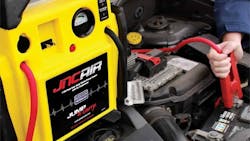A jump starter, no matter what type of battery powers it, is a perishable good. The battery contained in it, even if it’s best in class like our Clore PROFORMER batteries, will eventually decay to the extent that it’s no longer useful. That’s because, lead acid or lithium, all batteries are subject to the laws of chemistry and can only endure so many charge/discharge cycles in their useful lifetime. That said, there are many variables that can impact the “useful lifetime” such that a wide variety of outcomes or experiences can occur. So, what can you do to tip the scales in your favor and get a long life from your investment? Read on to learn more.
Charging is king
No different than your phone, your car, or any of the other battery-powered devices, appliances, and equipment in your life, your jump starter is always going to perform better and last longer if you keep it charged up and ready for service. This is true no matter the battery type involved. So, when you use it, charge it. If you go for a period without using it, charge it every 90 days or so. Doesn’t matter if it’s lead acid or lithium-powered. Every 90 days. Pop it on the charger in the evening and pull it off in the morning. Simple, quick, easy, and beneficial.
Nothing is worse than letting a device, such as your jump starter, sit in a discharged state for an extended period of time. Sure, it may not make sense to get it on a charger during that road trip, where you surprisingly needed to jump your vehicle three or four times along the way. But, where you get home, give it a good charge. Also, keeping it charged ensures that, when you next need it, it’s going to be ready.
Here’s the good news. All of our units feature automatic charging with overcharge protection. If you plug it in and forgot you did, no big deal. The unit will be brought to full charge and then held there with zero risk of overcharging. So, you really can’t do it wrong, as long as you do it.
Use it hard, but reasonably
Just like a welder or any other piece of equipment, your jump starter has a duty cycle. It is important to abide by that duty cycle. For most of our jump starter models, that means 6 seconds of cranking and 180 seconds of rest. The goal of the rest period is to allow internal components to cool down and prevent a massive build-up of heat, which is the enemy of just about any piece of industrial equipment. While our Clore PROFORMER and ES Series batteries are specifically designed for jump-starting and feature significant upgrades in construction and componentry, even they can be damaged by excessive cranking. So, to ensure a long life, give the unit the rest it needs. In the case of our lithium jump models, this rest period is built into the software to make it easy to avoid damaging the unit.
Storage temperature and charging frequency
Like any product with a battery, your jump starter’s ideal storage temperature is between 60-70 degrees F (~20 degrees C). No different than the battery in your SUV, it is going to lose some of its performance capability as it experiences extreme cold temperatures and will be stressed as it experiences extreme hot temperatures. So, in Buffalo, New York, in the middle of January, it’s going to have less oomph than it would on a pleasant spring afternoon. Likewise, on a hot Las Vegas summer day, the battery is going to be more stressed than on a pleasant spring afternoon.
That said, we realize that you live in the real world and that the whole reason you purchased a jump starter is because you need it in just those situations where outside temps are not ideal. Nobody handles the weather like Jump-N-Carry and Booster PAC. So, how do you get the most from your unit in these real-world conditions?
First, keep your unit charged. In bouts of extreme temperatures, it makes sense to charge your unit more frequently, such as every 30-45 days instead of every 90 days. Also, if your unit just came in from a very cold or very hot situation, give it an hour to adjust to room temperature before starting a charge. In periods of very extreme temps, take a few extra steps to ensure your unit will serve you well. So, if it’s going to be below -20 degrees F overnight and you have an important appointment in the morning, it might make sense to bring the unit in for that night. If you’re expecting highs above 120 degrees F, make sure your jump starter is stored in a place where it can get some air circulation and isn’t in direct sunlight. For instance, the glovebox isn’t the best place to store your lithium jump starter, even if it fits, because the lack of air circulation can cause it to be much hotter in the glovebox than other parts of the vehicle’s interior, such as under a seat.
Get it started and then disconnect
So, you’ve successfully started the vehicle, which is good news. But, once started, you may get distracted by what’s going on with it and forget that your jump starter is still connected to it. That’s less than ideal. Your jump starter will fare much better if, once the disabled vehicle has turned over and started, you disconnect the jump starter. Vehicle charging output is much higher than what your jump starter should see for any length of time. While it isn’t critical to rush to disconnect, it is a best practice to carefully disconnect the jump starter from the now-operating vehicle at the earliest possible convenience. Our lithium models have this feature built into them – as soon as the vehicle has started and the jump starter senses alternator output, they turn off the vehicle connection to protect themselves.
Safe behavior also improves longevity
Similar to the above recommendation to disconnect the jump starter at your earliest convenience once a successful start has occurred, other safety steps and procedures support your goal of getting the longest life from your jump starter. For instance, following the proper connection sequence and procedure has benefits for the health of your unit. Always first connect the jump starter’s positive lead to the battery’s positive battery terminal and then connect the negative lead to a good chassis or engine ground. Following this procedure every time decreases the likelihood of user error, such as a reverse connection, which can be very taxing on your battery’s health and very dangerous for you as the operator. Also, making sure that you have good connections reduces resistance while jump starting, which reduces the toll placed on the battery, cables, and clamps.
Overall checks and simple steps
Each time you deploy your jump starter, it is beneficial to give it a quick once-over to make sure it’s up to the tasks you expect from it. Are the cables and clamps in good condition with no signs of damage, frayed wires, or burnt clamp jaws? As important as it is to take care of your jump starter’s battery, it’s just as important to keep power path items, such as cables and clamps, in good condition. After each use, check the clamps for corrosion contact and wipe them down if corrosion is present, taking care not to allow it to contact your skin. For clamps that have a high level of acid contact and battery corrosion presence, a mixture of baking soda and water can be used with a wire brush.
You’ve made a serious investment by purchasing your jump starter and you want to get the greatest possible return on that investment. Following the above simple, basic steps can go a long way in helping you do just that. A little bit of extra planning and care can add months or years to the useful life of your jump starter.
About the Author

Jim O' Hara
Clore Automotive
Jim O'Hara has over 15 years experience in the Tool and Equipment industry, including 10+ years at Clore Automotive. At Clore, he heads up the marketing team and is directly involved in the development of new products and enhancements of existing products.
